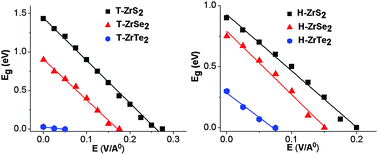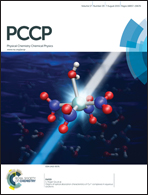Pressure and electric field-induced metallization in the phase-engineered ZrX2 (X = S, Se, Te) bilayers†
Abstract
The phase-, pressure- and electric field-induced changes in the electronic properties of Zr dichalcogenide, ZrX2 (X = S, Se, Te), bilayers are investigated using density functional theory. On going from the trigonal (T) to hexagonal (H) phase, a significant modulation in the electronic structure of bilayer dichalcogenides is predicted. This is mainly due to the distinct stacking nature of the bilayer in two phases leading to a delicate difference in the interplanar interaction, which is concurrently affected by the nature of X–X bonding. Application of the pressure reduces the band gap of layered dichalcogenides leading to the metallization of the ZrTe2 bilayer for ≈6 GPa. Similarly, application of the transverse electric field (0.05–0.25 V Å−1) induces a complete metallization in dichalcogenide bilayers. Our results show that band gap engineering by changing the phase, applying pressure and electric field can be an effective strategy to modulate the electronic properties of bilayer dichalcogenides for the next-generation device applications.


 Please wait while we load your content...
Please wait while we load your content...